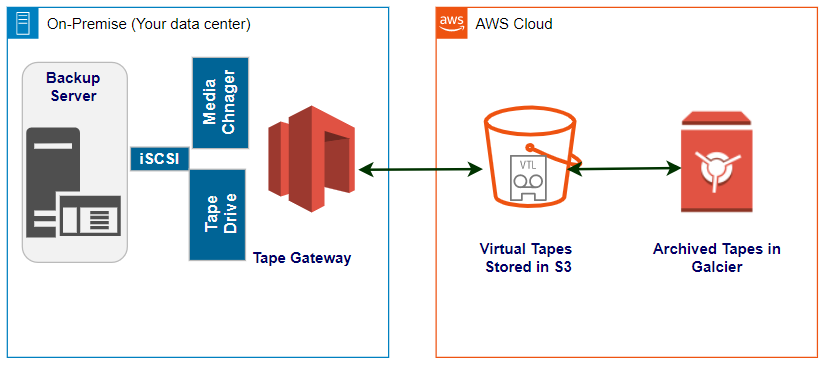What is Storage Gateway?
AWS Storage Gateway is a hybrid cloud storage service that connects an on-premises software appliance with cloud-based storage to provide seamless and secure integration between an organization’s on-premises IT environment and AWS storage infrastructure.
Use cases of storage gateway:
- Move on-premise backups and archives on the Cloud Storage. It helps to reduce the storage cost and reduce the maintenance work of your IT team.
- Provide on-premises applications with low latency access to data stored in AWS.

Important points of storage gateway:
- Organizations use storage gateway to simplify storage management and reduce costs for hybrid cloud storage. (Hybrid cloud storage means your data can be used on-premises and stored in AWS cloud storage services like S3, Glacier Deep Archive, EBS, etc.)
- Amazon Storage Gateway’s virtual appliance is available for download as a virtual machine (VM) image that you install on a host in your data center.
- Storage Gateway software, that can run on VMware ESXi, Microsoft Hyper-V, or Linux KVM on premises, as a hardware appliance on-premises, as a VM in VMware Cloud on AWS, or as an AMI in Amazon EC2.
- Once you have installed the storage gateway and connect It with your AWS account through the activation process, you can use the AWS Management Console to create the storage gateway option that is right for you.
Types of storage gateway
- File Gateway
- Volume Gateway
- Stored Volumes
- Cached Volumes
- Tape Gateway
File Gateway
File Gateway is a configuration of the AWS Storage Gateway service that provides an interface to store files (Flat files such as word, pdf, images, videos, etc.) as objects in Amazon S3 buckets, accessed through a Network File System (NFS) mount point.

- Files stored in S3, Also stores the metadata (Ownership, permissions, timestamps, etc.) of the object associated with the file.
- Once objects are transferred to S3 bucket, You can use the features of S3 such as versioning, lifecycle management, and cross-region replication to manage the files/objects.
- Use cases of File Gateway:
- Migrating on-premises application to the cloud.
- Backing up your on-premises data on cloud with less cost.
- Data Analysis by AWS services such as machine learning, big data analytics, or serverless functions.
Volume Gateway
Volume Gateway provides Amazon EBS Snapshots of your on-premises storage volumes that you can use for backup, disaster recovery, and migration. You can configure the AWS Storage Gateway service as a Volume Gateway to present cloud-based iSCSI block storage volumes to your on-premises applications.
- The volume interface presents your applications with disk volumes using the iSCSI block protocol. iSCSI protocol that enables you to transfer block data to hosts using SCSI protocol over TCP/IP.
- Volume Gateways compress data before that data is transferred to AWS and stored in AWS. This compression can reduce both data transfer and storage charges.
- Volume Gateway provides Amazon EBS Snapshots of your on-premises storage volumes that you can use for backup, disaster recovery, and migration.
- Volume gateway supports two types of configurations
- Stored Volumes
- Cached volumes
Stored Volumes
Stored volumes allow you to store an entire copy of your data locally for very low latency data access, while asynchronously backing up data to Amazon S3 as EBS snapshots.

Cached Gateway
Cached volumes allow you to use Amazon S3 as your data storage while retaining frequently accessed data locally on your storage gateway.

Tape Gateway
AWS Storage Gateway service can be configured to act as a Virtual Tape Library (VTL) that scales seamlessly with your business needs and helps to avoid provisioning, scaling, and maintenance of a physical tape infrastructure.
You can continue to use your existing backup applications and workflows while backup of virtual tapes is stored on Amazon S3. When you no longer require immediate or frequent access to data, you can backup application archive it from the virtual tape library into Amazon S3 Glacier or Amazon S3 Glacier Deep Archive for reducing storage costs.

